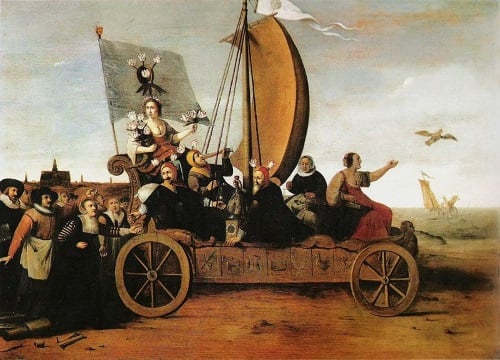
It should be simple: you want to describe a scene of people coming into a town for market. Or maybe it’s just a chance encounter on a road with some merchants. Or maybe it’s peasants on their way to market, loaded down with hay or squash. What are they carrying it in?
Answering the question isn’t a matter of a few minutes or even a few hours. There are whole books on this topic of wagons and transport, and the answers are complicated. Eh, oh well. Welcome to the Middle Ages, right? Everything here is complicated.
But for the writer, complicated is where the fun is.
Overview
Carts came first, then wagons, then trucks.
Even that simple statement is tricky, for “truck” is a verb that goes way back, at least to the early 17th century, but it was not used in the sense of a vehicle for carrying heavy loads until the late 18th century. So that part is easy: no trucks in the Middle Ages.
Carts are the oldest form of man-made transport. They appear with the earliest traces of cities, pulled by all sorts of animals from dogs to humans, and from goats to horses. A handcart is probably the oldest form, since all other types of carts require some sort of harness for the animal. They’re also the cheapest, so if your characters are poor (and if your world is quasi-medieval, then 80% or more of your characters are in fact poor), then they’re likely to be using a handcart. A handcart is really little more than a variation on the wheelbarrow.

Carts were in fact used for all sorts of special purposes. In these images we see a cart to hold a baking oven. Most households, especially in towns, did not have an oven–they bought bread from a baker. But as the image shows, in some cases, the baker might make house calls.
Don’t underestimate the utility of the handcart. Pioneers crossing the American West went the whole distance pushing a handcart, a distance of about 1300 miles.
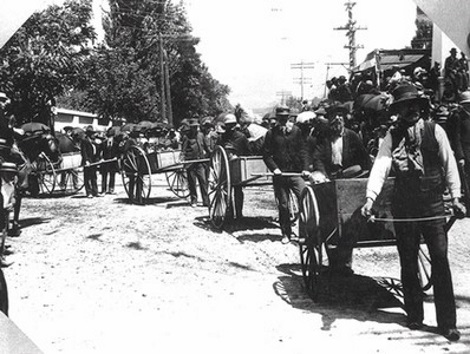
The Mormon handcart companies are a famous instance of this, whole trains of handcarts, pulled by simple human power.
Wagons
Wagons are more complicated. There are some historically important aspects you may want to keep in mind; specifically, spokes, wheels, and suspension. Taking the easiest first, you can forget about suspension. Springs in all forms are post-medieval, and even suspension using leather belts is very late (14thc) and expensive.
Spokes were a great innovation of the ancient world, replacing the simpler, cheaper but far less resilient wheel of solid wood. Roman wagons had ten spokes, but the number could vary. The wheels themselves were wood, but they could be rimmed with metal. Most importantly, the hubs were metal in ancient Rome, but it appears medieval wagons used wood hubs. These wear out much more quickly.
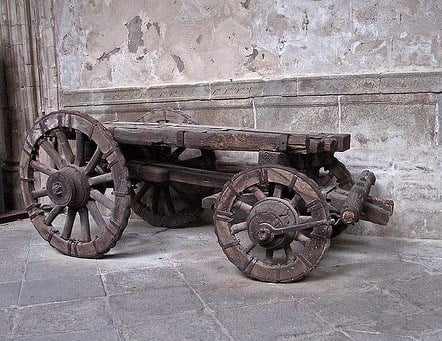
Land transport was far more expensive than shipping, perhaps ten times more, so merchants or armies needing to move goods over long distances used water whenever they could. The wagon was better for short haul, say a hundred miles or less. Longer was possible, of course, but you’d better bring repair kits.
Roads were poor anyway, and every bump was transmitted directly up to the cargo. This has some interesting consequences. For example, beer doesn’t do well shaken up, whereas wine does just fine. This is one factor (there were others) in why beer was such a local product while wine was an international trade item. Another consequence was that paved roads were hell on wheels (sorry, couldn’t resist). A cobblestone street was like a jackhammer, tearing apart wheel rims, breaking axles and spokes, and shaking the cargo. We are accustomed to thinking of paved roads as a Sign of Progress, and that medieval roads being unpaved was a sign of being technologically backward. It was in a way, but it was also not really practical to have paved roads until we had developed suspension systems that could stand up to the pounding. Even those famous Roman roads had wide paths on either side for wagons. The paved part was for the footsoldiers.
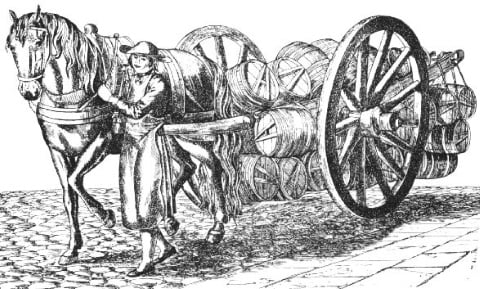
Spokes were one innovation, but probably the most important was the harness. So long as the beast of burden was attached to the wagon by wrapping something around the neck, transport was severely limited. You would choke the poor thing. The harness moves the weight down, around the shoulders and chest, which lets the ox or horse put its full strength into the pull. The harness was one of the great technological innovations of the Middle Ages.
Carriages and Other Newfangled Devices
“Carriage” was derived from cart (“car” is an alternate form of “cart”); originally it denoted the means of transport–á la cart = carriage. Eventually it designated a particular kind of four-wheeled vehicle intended specifically for carrying people. Leather suspension was used at first, but in the 17th century came the great innovation of spring suspension, which was nothing more than curved bars of metal on which the carriage body rode, bending down and back up. What luxury! Why, one could even travel in comfort on city streets.
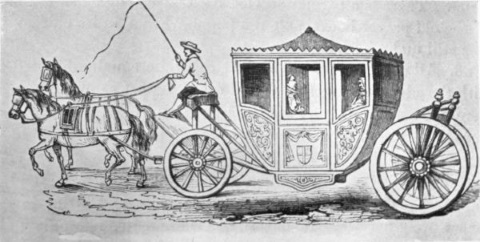
Then there is the tumbrel, which is indelibly linked to the French Revolution, but which in fact was an ordinary two-wheeled farmer’s cart. Its big wheels and high sides were perfect for carrying hay or other harvested goods. Or traitorous enemies of the République.
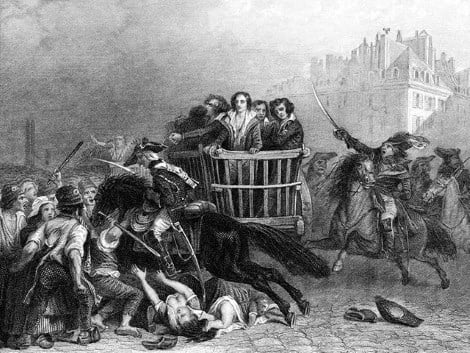
With the discovery of rubber and rubber processing, wheels could be put on that made the ride even better [646]. Between metal hubs, rubber tires and spring suspension (coiled springs), the ride became smooth as … if not silk, then perhaps cordouroy. And so we can return to trucks, which was a term in use before the development of the internal combustion engine. In the 19th century it was quite common to see trucks pulled by horses.
By the 19th century, we have a wide array of wheeled transports, including chaises, charabancs and coaches. Since modern history is not my field, I’ll leave off there.
For the Writer
Let’s establish this at the outset: high-speed wagon chases are right out. <grin>
Which is another way of saying that a wagon is not likely to occupy the foreground of your story. The information here is almost literally background—just a detail to use here or there. Even so, I’m hoping that you might be able to use one of those details in an interesting way. You could imagine an overturned or stuck wagon, a runaway, even a traffic jam. One of my favorite wagons is Nordic, in which the body of the wagon could be lifted off the wheels in winter time, converting it to a sled.
One type of wagon you may not think about right off is the medieval pageant wagon. These were used in medieval cities on which to stage plays or other public demonstrations, and were also used by traveling theater troupes as the means to bring their stage from one village to the next. Medieval pageants, by the way, provided an important source of work for artists. Even famous ones like da Vinci or Michelangelo got at least occasional work from painting sets or designing these pageant wagons.
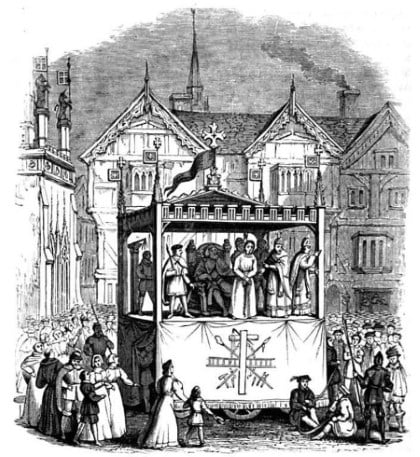
I provide one image here, but if you do a search you will find a number, some incredibly elaborate. The point, of course, was to show off the skill and wealth of a particular guild, abbey, or town, rather like floats in a modern-day parade. Such a pageant wagon could do good work as a Trojan Horse or the setting for a spectacular assassination. Or a romantic proposal. We don’t have to be all blood and murder, do we?
I’d love to hear if this article has sparked any ideas of your own.
Further Reading
Gerhold, Dorian. Road Transport Before the Railways, Cambridge 1993
Gies, Frances & Gies, Joseph. Cathedral Forge and Waterwheel: Technology and Invention in the Middle Ages, Harper Perennial Edition (Paperback), New York, 1995
Gimpel, Jean. The Medieval Machine, New York, Penguin Books, 1977
Leighton, Albert C. Transportation and Communication in Early Medieval Europe AD 500-1100, David & Charles, 1972
E.L. Skip Knox is the creator of the fantasy world called Altearth, a place where magic is real, monsters roam the land, and the Roman Empire never fell.


Hi, Thanks for the very informative article
I have one point of clarification, regarding harness. The invention of the harness was pretty much a equine exclusive technology. Yokes, although primitive seeming, work extremely well with bovine anatomy, which is why oxen were the primary draft animal for all heavy work until the invention of the horse collar.
For one thing, just about half the world that uses oxen and yokes them to a load uses/used horn yokes. Where the yoke is a beam that is tied directly to the horns of the team. This is obviously impossible to choke them with.
This system is enormously popular historically and today in subsistence agricultural economies that still exist.
The other forms of yoke use a beam that rests on the shoulders of the bovine, with some form of wood or fiber restraint wrapping around the neck. This works well with the anatomy of the bovine skeleton and very horribly with the equine skeleton. A yoke beam is pushed against by an ox’s withers and shoulders, while a horse has to pull it with the soft portion of its neck, choking it.
In order to get efficient draft from an equine you had to isolate the point of draft to the rear and sides of the shoulder while avoiding any compression on their airway. The collar of a harness does this.
You can put a bovine in a collar and make it work, but it doesn’t actually work better than a yoke, relative to the cost and maintenance of the harness itself. Horse are stronger and faster than cattle, but more expensive to feed and maintain. The cost benefit of yoke vs harness with cattle vs horses is easy to understand.
There were large transports, but pretty much only on water. There were too many difficulties with overland. The wagons had no suspension, so they broke down under heavy loads, especially the wheels. The animals needed to haul transport added to cost. The roads themselves might turn muddy–most dangerous were potholes.
Water was just plain cheaper. I know, for example, that millstones were shipped. These could be very large and very heavy. Marble is another example of moving large, heavy loads. Horses, too, could be and were shipped.
So you had two choices. Locate your furnace next to ample resources, or locate it near water. The latter had one more difficulty, though. There were other products more profitable than your coal or limestone. So, getting room on the boat might be problematic.
Hope that helps!
Thanks so much for sharing your knowledge, Skip! The part about the Nordic wagon that could be converted into a sled piqued my interest, but I’m struggling to find any mentions of it in the sources that I could access. Do you have a specific source that you could refer me to for further reading?
I don’t have a specific reference, but I’m pretty sure it’s in Leighton. Alas, I no longer have that book and cannot search it. As I remember, it was a simple matter of lifting the bed off the carriage and either using it directly or setting the bed on a frame of skis or skids.
Thank you for the quick response! I’ve ordered the book myself now, and will see if I can find the relevant passage (and if not, it sounds like a solid read either way!)
Not really a medieval thing. Even for the Romans, chariots were mainly used for important people to wave to the crowds from the back of one in ceremonial processions or in circuses for racing. The Romans didn't regard the chariot as a practical military weapon and it wasn't really practical for transporting trade goods (stuff being likely to fall off the back and all).
The heyday of the chariot as a military weapon was really during the bronze age – before cavalry proper came on the scene.
heya sorry trying to make a ruling on standard weight and volume for the following vehicles in dnd cart weighing 200 pounds waggon weighing 400 pounds and i want to add a larger vehicle thats built as a bulk hauling vehicle in a largely land locked nation where rivers are pretty unsafe for hauling cargo. is there anything i could use to help with that.
Thanks. I'm glad you found something of use in there.
Thank you skip.knox! This was very insightful. Never really thought about this level of detail before. Now that i read it, its very interesting and makes a difference.
And don't forget a cart. Some terminology has to do with the number of wheels. Some has to do whether it is enclosed or not. I honestly wouldn't sweat it unless the story turned on the distinction.
But if it did, I'd look up the history and the etymology. That'd give me a fix on when the word "carriage" (for example) first appears. Do the same for other terms and I'd have at least a kind of Venn diagram for wheeled conveyances.
Whenever I find myself worrying too much over the "correct" use of a word, I go looking at the same term in other languages. That usually reminds me that language is wonderfully flexible and that what's right for one time and place isn't necessarily right in another. And that at least some modern readers are very likely to have a wrong idea about what's right and will criticize my right usage as wrong. <g>
Thanks for the post. I have recently had an issue with "is it a Wagon, a Carriage, or a Coach?" In a a trade caravan, is it one or the other, or all three… is it all just wagons even if some are only carrying people? small things but it does matter.
This is post medieval perhaps-
Hi, I wonder if you can help me please, I’ve read ‘A Memoir of Robert Blincoe’, https://archive.org/details/BROWNJohn1832AMemoirofRobertBlincoe/page/n13/mode/2up who was born in 1792 and sent from a London workhouse at the age of 7 to be apprenticed in a cotton mill. The children were sent in a waggon which had ‘grated doors’ that were locked. There was straw inside with ‘beds’. I intend to write a story which includes children being conveyed from a London workhouse to a cotton mill in Nottinghamshire at the end of the 1700s but I’m finding it hard to imagine what this wagon looked like. I’ve searched on the Internet and found two images that I think might fit the bill but they are prisoner transport wagons. Do you know of any information or images I could see which would allow me to visualise such a wagon which might have been used to move a large group of children in 18th century and what it might have been like inside, please?
This is rather beyond my area by a few centuries, but I can make a guess or two that might help. The most likely approach would be to take a regular wagon and put a cage or cages on it. There just wouldn’t be any economic sense to constructing a special-purpose wagon. Those grated doors might be entirely iron, like bars on a jail cell, but they might just as well be wooden doors with an iron grate window for air. There might even be holes drilled through the wood for air, like one might do for a small animal box.
The “large number” gives me pause. Wagons weren’t all that big, and the bigger they were, the more oxen needed to pull the load, all of which drives up cost, and there wasn’t much money to be had from workhouse children. Free work for the mill is about all, so the owner would be looking to reduce cost.
Daily necessities would mean a bucket for slop. Feeding would be done inside–you can’t let them out for fear of escape, for which the transport company would have to pay. A very few days of this would be all right, but too long a journey and you start having dead kids.
Anyway, for visualization, just a sturdy farm wagon with sides, one or two boxes of kids on board, pulled by four oxen. If you want to add a bit, the wagon could suffer a breakdown. If you really need lots of kids, maybe more than one wagon?
All the best on your story.
Thank you very much! That’s great!
The design of wagons… fixed front wheels or ona swivel, is also one of those important little tidbits that my brain hit at some point. I was impressed to see that I had a similar design thought to the Romans when thinking about it, heh heh.
I know wagons were pretty much for the rich; only one of my characters has one that is horse drawn. Oh, well the High Priest has a horse drawn coach. I appreciate the mention of the bakers, and other hand carts. I’ll have to keep that in mind as I describe the marketplace and the barrows. Thanks for the post.
You’re welcome! I’m glad you found it of use. You’re right that wagons were expensive. Sometimes there would be a peasant or tradesman in a village able to afford one and it might get borrowed a lot. Like being the only one in town with a pickup truck.
I truly appreciate the information listed here. I’m writing the second book of my Fantasy Allegoric Series “Rebirth if Eirinth” and needed some information about when wagons came into use. Even though my world is set in an alternate dimensional world to Earth, and it has many differences to our Medieval era in ways, I still try to get the food, conveyances, weapons, clothing, and even use of bows, arrows, swords, daggers, and spiritual gifts related to Christianity as believable as I can. Check out BREAKING THE SHACKLES by Tonja Condray Klein and my original CD under Tonja Klein currently as “Eirinth Breaking” that has lyrics from three of the songs used in Book 1. TREADING THE PATH is currently in progress so THANK YOU for this information! Visit the website for links to the music to listen to for FREE, to see original artwork by commission since 2009 that you can view for FREE, and the Sample of Book 1 that has Prologue through Chapter 6 you can read for FREE! “May Tenrai Daystar shine down on you with blessings beyond sublime dreams!” Eirinthian Blessing by Tonja Condray Klein(c)2009-2019 ~ TK ~
Well, carts is important.
That's how yoos get stuff to places.
That's what I remember as well, Psycho Wizard. Then again, that comes from so long ago that the memory itself is ancient history!
Always been lead to believe the oldest carts were made by the Sumerians, or at least the oldest we've found to date.
Thank you, Skip!
I have indeed researched the Battle of Sluys, and also the Battle of Crécy and that of Poitiers. All of them are mentioned in my Joan of England story, but they are never seen directly since only part of the first novel takes place in the 14th Century.
For the article, I think it would be great if you describe the ships of those times in detail.
Many people assume that all wooden ships of centuries ago were pretty much the same, when in reality there were many different types and sizes and also they changed a lot with the passing of time. In Joan I did not describe the ships in great detail because my research was not that good, so it would be great to know more about this.
There are so many fascinating things about Medieval life that more people should know about.
Thanks, Shiela. I have enough stuff on medieval naval matters to occupy at least a couple of articles. I'm guessing you researched the Battle of Sluys, yes? There's lots to say on the subject.
As for the wagon chase scene, you will get some good visuals by watching old American westerns, where they show both wagons and stagecoaches at high speed. It's funny how similar they are in their narrative to car chases–much careening, quick cuts, followed by the inevitable tipping over. 🙂 Even so, you'll get a pretty good idea of handling and the ride, since those older movies and TV shows used real wagons and horses going over real dirt roads. The older the movie the better.
To put it briefly, chases yes, but nothing high speed, at least as measured by modern standards. Certainly breathlessly fast for the people in the wagons. And good opportunities for a daring jump or two. Now I think about it, adding magic abilities into the mix could certainly provide some interesting novelty.
Thanks for the comment!
Hello Skip!
I love how you talk about Medieval life in such a natural and familiar style. You are very good to explain many aspects of what the Medieval world was really like, it's all clear like water and at the same time you add nice touches of good humor. Thanks to your article, I have learned more about the history and evolution of carts and carriages.
Certainly it would be strange to find a high-speed chase with carriages in a Medievalish story, but what would actually happen?
Let's say that the road is very smooth dirt, and the escaping carriage is really desperate to get away as fast as possible. Would that be a terribly bumpy experience for the driver and the people inside of that carriage? How fast could they actually go? How long would pass before the carriage's safety is compromised?
In my Joan of England trilogy I have some carriage scenes, but they were used only to transport Joan and her entourage from her residence at Surrey to the nearby Portsmouth.
I have an idea for a future article of yours: What were naval battles really like in the mid 14th century, for example at the start of the Hundred Years war? I know the answer to this because I have researched the war adventures of Joan's father Edward III, but the article could be great for people that do not know this type of information.
Cheers, Skip! Congratulations for a great article.
Great article as usual Skip. The minute I saw the title I thought of the War Wagons of the Hussites. The middle ages were never boring!
Thanks for the overview, Skip! Good to know the eras of each. This is something I’ve thought of fairly often, around story logistics, but never done more than a quick google about it… Usually I just spell wagon “waggon” and hope that conjures up a sufficiently antiquated image! Researcher I am not…
That's the thing… this is an article for a writing blog. It's meant to be a basic primer on the subject, to prevent writers from making the most basic of errors. There is only enough space to scratch the surface. To go truly in depth would require either a book or a whole series of articles on this one subject.
If you wish to explore this subject further, you are welcome to write a follow-up article that goes deeper into the areas that interest you. Here are the submission guidelines:
Write for Mythic Scribes
That's on me. I added the image of the cart with the sail after the article was submitted.
No mention of chariots? I guess not very medieval, but neither is any mention of Romans, da Vinci, or Michaelangelo.
No mention of the chinese one wheeled carts, and how they fair better on rough roads, or of the evolution of the wheelbarrow from the barrow, or of leather tires? No mention of the importance of where the center of gravity is in relation to the axle/axles, or of different types of harnesses or yokes. I see you put in a picture of both a cart pushed from the front and from behind and of a wagon with a sail, and mentioned neither, in spite of the fact that both where commonly used. Also no mention of horse drawn railroads, or of the smoothness of Roman roads – many are still good, smooth, serviceable, paved roads, even now, 500 years after the period you are writing about.
Just so I don't sound hypercritical: I really like this series of articles, and this happens to be a favorite subject of mine, so I feel a need to attack it. I feel this is a vast and rich subject and you have barely scratched the surface.
I should make it clearer that I’m a medievalist and my posts concern that era (and place), with an occasional straying into late Rome. Thanks for the comments.
Very interesting information. I'd hoped for more 19th century stuff, since that's my area of interest. Still, I have some knowledge of my own in that area if anyone is curious.
Another important thing to understand is that public transport as we understand it did not exist prior to the 18th century. Before then, you either walked, rode or drove yourself, or hitched a ride with someone going in the same direction. Vehicular transportation was heavily freight-oriented, and carrying people other than the crew was an afterthought at best. There wasn't much call for passenger transport since people rarely traveled far from their home unless their job required it. Given the dangers and ordeals they had to face, can you really blame them? The coach was the first vehicle (that I am aware of) that was specifically designed to carry passengers. Then, somebody in 18th century England had the bright idea to let people ride a coach for a fee. These coaches that anyone (with enough money) could use, and which went to fixed destinations and arrived and departed (ideally) at fixed times was a thing unheard of before then. Combined with better suspension and Macadamized roads (a method still used to build unpaved roads to this day), this ushered in a revolution in transport that came to full flower in the 19th century. A lot of modern-day vehicles such as taxis, buses, trucks (as mentioned above), and even trains got their start with horse-drawn predecessors.
Also, when it comes to stagecoaches at least, a high-speed chase is not out of the question. Speed was important to the stagecoach companies, and coaches from rival companies would sometimes race each other, even though they weren't supposed to, and these horse-drawn drag races often ended badly. Of course, this requires a setting that has stagecoaches or something similar.
I agree that someone should add in post-medieval stuff, not merely for transportation but for the other facets of life I write about. The early modern era saw significant change, and of course the Industrial Revolution, along with other shifts (Hobsbawm’s “dual revolution”), changed pretty much everything.